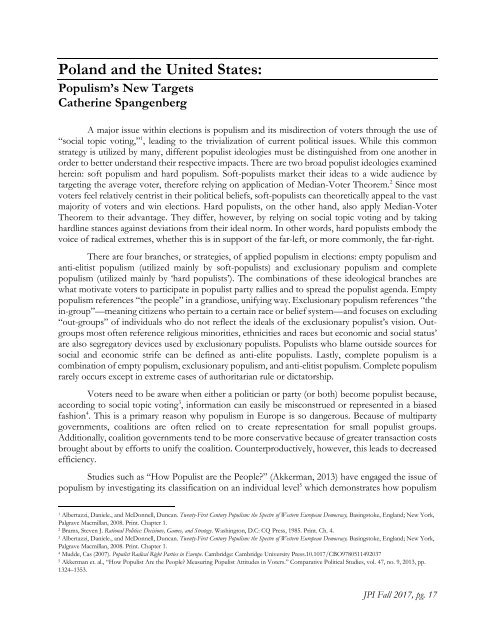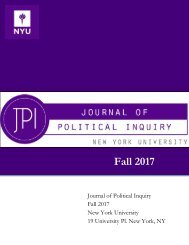JPI Spring 2018
Create successful ePaper yourself
Turn your PDF publications into a flip-book with our unique Google optimized e-Paper software.
Poland and the United States:<br />
Populism’s New Targets<br />
Catherine Spangenberg<br />
A major issue within elections is populism and its misdirection of voters through the use of<br />
“social topic voting,” 1 , leading to the trivialization of current political issues. While this common<br />
strategy is utilized by many, different populist ideologies must be distinguished from one another in<br />
order to better understand their respective impacts. There are two broad populist ideologies examined<br />
herein: soft populism and hard populism. Soft-populists market their ideas to a wide audience by<br />
targeting the average voter, therefore relying on application of Median-Voter Theorem. 2 Since most<br />
voters feel relatively centrist in their political beliefs, soft-populists can theoretically appeal to the vast<br />
majority of voters and win elections. Hard populists, on the other hand, also apply Median-Voter<br />
Theorem to their advantage. They differ, however, by relying on social topic voting and by taking<br />
hardline stances against deviations from their ideal norm. In other words, hard populists embody the<br />
voice of radical extremes, whether this is in support of the far-left, or more commonly, the far-right.<br />
There are four branches, or strategies, of applied populism in elections: empty populism and<br />
anti-elitist populism (utilized mainly by soft-populists) and exclusionary populism and complete<br />
populism (utilized mainly by ‘hard populists’). The combinations of these ideological branches are<br />
what motivate voters to participate in populist party rallies and to spread the populist agenda. Empty<br />
populism references “the people” in a grandiose, unifying way. Exclusionary populism references “the<br />
in-group”—meaning citizens who pertain to a certain race or belief system—and focuses on excluding<br />
“out-groups” of individuals who do not reflect the ideals of the exclusionary populist’s vision. Outgroups<br />
most often reference religious minorities, ethnicities and races but economic and social status’<br />
are also segregatory devices used by exclusionary populists. Populists who blame outside sources for<br />
social and economic strife can be defined as anti-elite populists. Lastly, complete populism is a<br />
combination of empty populism, exclusionary populism, and anti-elitist populism. Complete populism<br />
rarely occurs except in extreme cases of authoritarian rule or dictatorship.<br />
Voters need to be aware when either a politician or party (or both) become populist because,<br />
according to social topic voting 3 , information can easily be misconstrued or represented in a biased<br />
fashion 4 . This is a primary reason why populism in Europe is so dangerous. Because of multiparty<br />
governments, coalitions are often relied on to create representation for small populist groups.<br />
Additionally, coalition governments tend to be more conservative because of greater transaction costs<br />
brought about by efforts to unify the coalition. Counterproductively, however, this leads to decreased<br />
efficiency.<br />
Studies such as “How Populist are the People?” (Akkerman, 2013) have engaged the issue of<br />
populism by investigating its classification on an individual level 5 which demonstrates how populism<br />
1<br />
Albertazzi, Daniele., and McDonnell, Duncan. Twenty-First Century Populism: the Spectre of Western European Democracy, Basingstoke, England; New York,<br />
Palgrave Macmillan, 2008. Print. Chapter 1.<br />
2<br />
Brams, Steven J. Rational Politics: Decisions, Games, and Strategy. Washington, D.C: CQ Press, 1985. Print. Ch. 4.<br />
3<br />
Albertazzi, Daniele., and McDonnell, Duncan. Twenty-First Century Populism: the Spectre of Western European Democracy, Basingstoke, England; New York,<br />
Palgrave Macmillan, 2008. Print. Chapter 1.<br />
4<br />
Mudde, Cas (2007). Populist Radical Right Parties in Europe. Cambridge: Cambridge University Press.10.1017/CBO9780511492037<br />
5<br />
Akkerman et. al., “How Populist Are the People? Measuring Populist Attitudes in Voters.” Comparative Political Studies, vol. 47, no. 9, 2013, pp.<br />
1324–1353.<br />
<strong>JPI</strong> Fall 2017, pg. 17
















